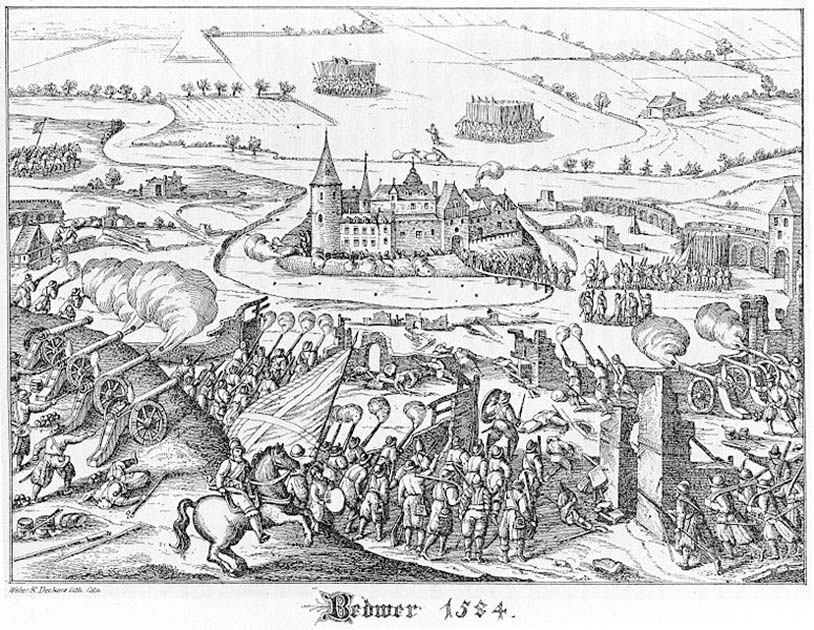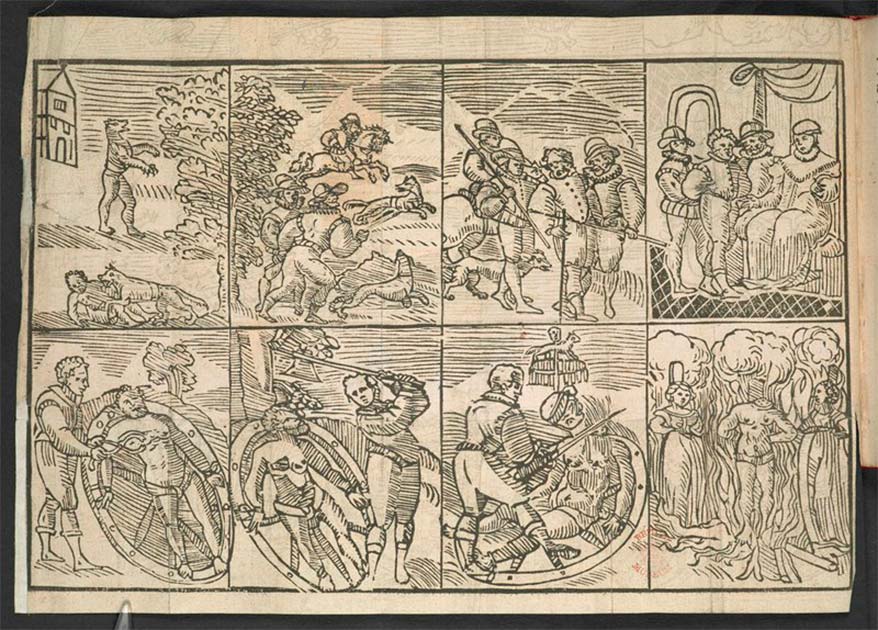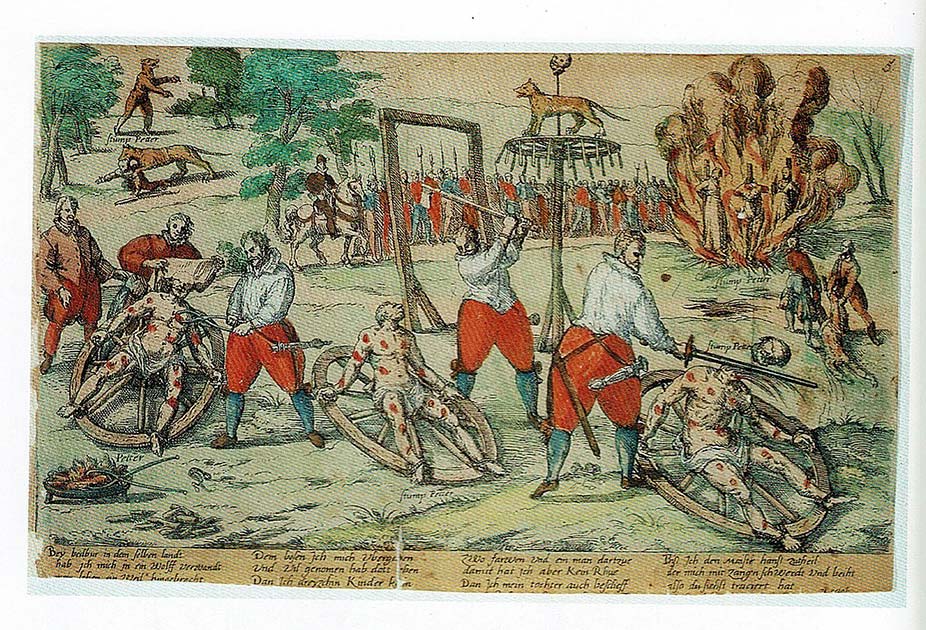European history is full of real-life monster stories. For centuries Christians were convinced that the likes of witches, ghosts, demons, and vampires were not just real but going around killing people.
The story of Peter Stumpp is a classic example. Stumpp found himself accused of acts so heinous, so unspeakable, that the only rational answer people could come up with was that he was a werewolf.
Unlike other fantastical tales however, when examined with a rational eye Stumpp’s story only becomes more monstrous. His confession, gained through the use of torture, led to one of the most brutal executions in European history.
As history intersects with folklore, we find ourselves asking was Stumpp guilty of the crimes of which he was accused? Or was he a victim of a much darker plot?
Peter Stumpp
Historians have been left stumped when it comes to much of Peter Stumpp’s early life. His year of birth is believed to have been around 1530 in the village of Epprath, near Bedburg, Germany.
His name may not have even been Stumpp. He has also been referred to as Abal Griswold, Abil Griswold, and Ubel Griswold and it’s thought the name Stumpp may come from the fact that his left hand had been cut off, leaving only a stump.

As for his adult life, we think that he was a wealthy farmer, that he was a widower, and that he had two children: a daughter Beele, and a son whose name has been lost. As for his character, it seems up until his exposure as a werewolf he was pretty well-liked. A late 16th century English pamphlet described him in the following manner:
“He would go through the streets of Cologne, Bedburg, and Epprath, in comely habit, and very civilly, as one well known to all the inhabitants thereabout, and oftentimes was he saluted of those whose friends and children he had butchered, though nothing suspected for the same.”
But we have extraordinarily little concrete information on the life of Stumpp if that even was his name. The problem is that church records for the period were burnt during the Thirty Years War. His case was also so well known that anything written after his death tends to be false, inaccurate, or heavily sensationalized.
The Werewolf of Bedburg
Life changed for Stumpp starting in the mid-1560s when increasing numbers of mutilated cattle began turning up around Bedburg, their abdomens ripped open. Initially, local villagers blamed wolves but then things took a turn.
Women and children also began to disappear, snatched from the streets with their mutilated corpses turning up a few days later. The superstitious townsfolk soon decided something unnatural was at work.
People were afraid to leave home and resorted to only going out as part of armed patrols. Those brave enough to travel between towns reportedly found the dismembered limbs of victims abandoned in fields. If a child went missing, even for just a few hours, the parents would immediately give up all hope, believing a monstrous wolf had gotten to them.
There was no easy fix, either: things continued this way for the next 25 years. Countless men, women, and children, as well as livestock, are said to have gone missing. As time went on people became increasingly convinced that a monster was behind the disappearances.

Things did finally come to a head though in 1589. Reportedly, children were playing in a meadow when a large wolf emerged from the nearby woods. Before the children could flee it grabbed a girl by her coat collar.
Luckily for the girl, her collar was so stiff that the wolf’s teeth failed to pierce it. Before the wolf could grab its meal, the children raised the alarm and the creature was forced to give up and flee. Villagers chased after the wolf and believing it to be cornered, went in for the kill.
Yet as they closed in, the wolf was nowhere to be found. In its place was Peter Stumpp. Whether or not the men saw Stumpp or not, as well as if they captured him there and then or later, varies between accounts.
Stumpp On The Rack
Stumpp was in for a tough time. After being captured he was stretched on the rack until he was ready to confess. It didn’t take long for the man to break.
Fearing further torture, he confessed to having been a practitioner of black magic since he was 12 years old. He stated that the Devil had rewarded him for his loyalty with a magical belt or girdle, that allowed him to transform into “the likeness of a greedy, devouring wolf, strong and mighty, with eyes great and large, which in the night sparkled like fire, a mouth great and wide, with most sharp and cruel teeth, a huge body, and mighty paws.”
Stump said that taking off the belt reversed the transformation. When a local magistrate asked him where the belt was, Stumpp replied that he had left it in a “certain valley.”
A bailiff was sent to return the belt, but couldn’t find it. The fact the belt was never found, nor the fact Stumpp’s story didn’t line up with how he was discovered, didn’t seem to bother anyone.
Under the threat of more torture Stump admitted to being an “insatiable bloodsucker” who had killed and eaten at least 14 children and 2 pregnant women, amongst countless others over a 25-year period. His descriptions of the pregnant women were particularly harrowing, he claimed to have ripped their fetuses from their wombs and “ate their hearts panting hot and raw,”.
- Violence in the Night: Enriqueta Marti, the Vampire of Barcelona
- Clairvius Narcisse and His Haitian Zombie Experience
His son was also said to have been one of the 14 children he had eaten. Apparently, he had not wished to harm his son, but his bloodlust eventually prevailed, forcing him to take his son out into the woods and devour him.
From there the confessions just kept coming. On top of being a serial killer werewolf Stump also confessed to being in an incestuous relationship with his 15-year-old daughter. On top of this, he admitted to having a mistress who was also a distant relative which the law also considered incestuous. Quite the supernatural lothario, Stumpp finally admitted to having had sex with a succubus, sent to him as a gift by the Devil.
An Execution Most Foul
Safe to say Stumpp’s trial didn’t go well for him. He, his daughter Beele, and his mistress Katherine were also sentenced to death. Stumpp’s death in particular was incredibly unpleasant, and is probably one of the most brutal executions on record.
He was first attached to a wheel and had the flesh torn from his body in ten different places with red-hot pincers. The same was then done to his arms and legs.

Next, the executioner used the blunt side of an axe to break all of Stumpp’s limbs. This was done to make sure he couldn’t crawl out of his own grave. Finally, he was beheaded and burnt on a pyre.
Katherine and Beele fared little better. They had already been flayed alive and strangled and were burnt alongside Stumpp. Local authorities then erected a pole with the torture wheel on top with a model wolf attached to it. At the very top was Stumpp’s mangled, severed head.
To this day it’s unclear why the people of Bedburg decided Stumpp was a werewolf. Some historians believe it’s possible that Stumpp was in fact a murderer, maybe even a cannibal. His crimes were just so heinous that the only way people could understand them was to say they were supernatural.
It’s also likely that the rumors surrounding Stumpp, his daughter, and his mistress added fuel to the fire. People were looking for a monster and who better to accuse than a widower who sleeps with his family members and whose son disappeared under suspicious circumstances? There may also have been some jealousy in play thanks to his wealth.
It’s also possible that Stumpp was innocent and was nothing more than a scapegoat. Stumpp’s trial took place during the Cologne War of 1583-88, a fight between Protestants and Catholics. Stumpp was a former Catholic who had openly converted to Protestantism. Is it possible that the Catholics (who controlled Bedburg at that time) decided to make an example of Stumpp? Stranger things have certainly happened.
Peter Stumpp wasn’t alone. Werewolf trials were surprisingly prevalent in Europe from the early 15th to 18th centuries and often went hand in hand with witch-hunts, although werewolf trials tended to be much more uncommon. Just as the women accused of being witches tended to be nothing more than scapegoats, the same could be true for Stumpp.
Top Image: Was Peter Stumpp guilty of the crimes of which he was accused? Source: Justlight / Adobe Stock.